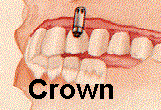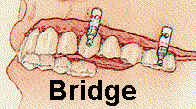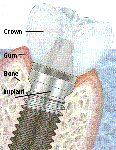Dental implants can be the next best thing for
you if you are missing any of your teeth! When any teeth are lost, great consideration
should be immediately given to replacing the lost teeth. Implants may be your best choice.
They are "titanium roots" and can be used to anchor crowns, bridges, or dentures
(see the diagrams below).



Usually, there are only three dental choices to replace lost teeth. First, a removable
appliance, like a conventional denture without implant support, could be fabricated.
Comfort, as well as reduced chewing function are the most frequent complaints heard from
patients with these types of restorations. Secondly, cemented or "fixed"
bridgework can often be utilized. Fixed bridgework requires the "filling" down,
or preparation of the neighboring teeth, to support it through the use of crowns. These
usually are very comfortable and almost never result in an embarrassing situation where
the restoration falls out during a social occasion. The third and worst choice is to do
nothing and to learn to live with your tooth loss. This can lead to serious bite problems
resulting from additional strain on the jaw joint or "TMJ" as well as
periodontal complications from drifting teeth. Implants now offer a solid fourth
choice.
 A multitude of major university
research studies have demonstrated the safety and effectiveness of dental implants. They
have been studied in one form or another for the past 25 years. Today's systems are highly
successful and offer predictable results.
A multitude of major university
research studies have demonstrated the safety and effectiveness of dental implants. They
have been studied in one form or another for the past 25 years. Today's systems are highly
successful and offer predictable results.
Very simply, implants are "titanium roots." They are precisely placed into
the jaw bone and allowed to "integrate" or heal to the bone. While the
implant(s) are healing a temporary restoration is usually employed. The resultant
integration is stronger than the union of a natural tooth to the jaw bone. After a
sufficient period of healing, the teeth are placed into the implant body.
Dental implants are so natural-looking and feeling, you may forget you ever lost a
tooth. You know that your confidence about your teeth affects how you feel about yourself,
both personally and professionally. Perhaps you hide your smile because of spaces from
missing teeth. Maybe your dentures don't feel secure. Perhaps you have difficulty chewing.
If you are missing one or more teeth and would like to smile, speak and eat again with
comfort and confidence, there is good news! Dental implants are teeth that can look and
feel just like your own! Under proper conditions, such as placement by a periodontist and
diligent patient maintenance, implants can last a lifetime. Long-term studies continue to
show improving success rates for implants.
What Dental Implants Can Do